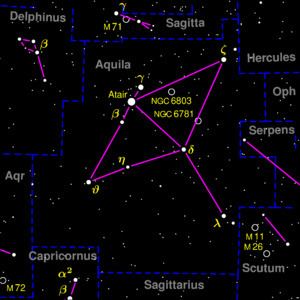Magnitude 3.43 Apparent magnitude (V) 3.43 | ||
 | ||
Similar Theta Aquilae, Delta Aquilae, Eta Aquilae | ||
Lambda Aquilae (λ Aql, λ Aquilae) is a star in the constellation Aquila. It has the traditional name Al Thalimain, which it shares with ι Aquilae. The name is derived from the Arabic الثالمين al-thalīmain "the two ostriches". Lambda Aquilae is more precisely Al Thalimain Prior. It has an apparent visual magnitude of 3.43, which is bright enough to be seen with the naked eye. Parallax measurements place it at a distance of about 125 light-years (38 parsecs) from Earth.
Contents
In Chinese, 天弁 (Tiān Biàn), meaning Market Officer, refers to an asterism consisting of λ Aquilae, α Scuti, δ Scuti, ε Scuti, β Scuti, η Scuti, 12 Aquilae, 15 Aquilae and 14 Aquilae. Consequently, λ Aquilae itself is known as 天弁七 (Tiān Biàn qī, English: the Seventh Star of Market Officer.)
Properties
Lambda Aquilae is a main sequence star with a stellar classification of B9Vn, which means that, like the Sun, it is generating energy at its core through the nuclear fusion of hydrogen. It is more massive than the Sun, with about three times its mass, and radiates about 55 times the Sun's luminosity from its outer envelope at a higher effective temperature of 11,780 K. This temperature gives Lambda Aquilae the blue-white hue that is a characteristic of B-type stars. Lambda Aquilae was one of the least variable stars observed by the Hipparcos satellite. It is a suspected Lambda Boötis star and has an age of about 160 million years.
This star lies about 5° from the galactic plane and about 30° from the line of sight to the Galactic Center. This region of the sky is crowded with other objects along the line of sight, with at least 55 located within 10 arcseconds of the star. Examination of the star shows no companions with an 85% probability. Despite this, it is suspected of being a spectroscopic binary star. That is, it may have an orbiting companion whose presence is revealed by displacements in the absorption lines in the spectrum caused by the Doppler effect. Based upon the width of these lines, the star is rotating rapidly, with a projected rotational velocity of 103 km s−1.
Related space mission
NASA's Pioneer 11 space probe, launched in April 1973, exited the solar system in 1990 and continued in the direction of Lambda Aquilae. It is estimated that it will take around 4 million years for the probe to make its closest approach to its destination, assuming it will remain intact. However, NASA stopped communicating with Pioneer 11 since November 1995 because the space probe's power was already too weak to transmit any data.
